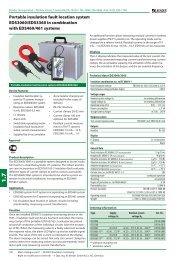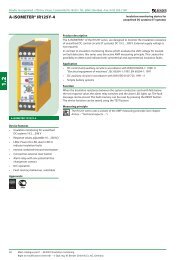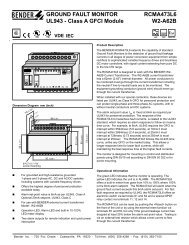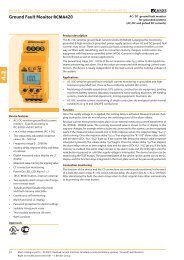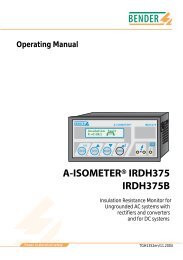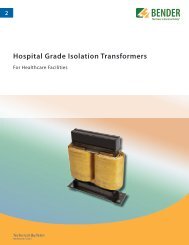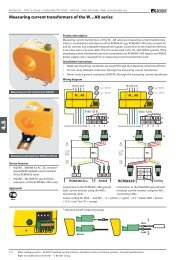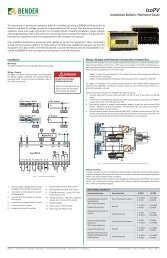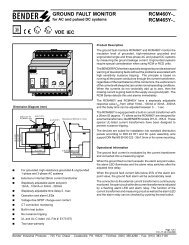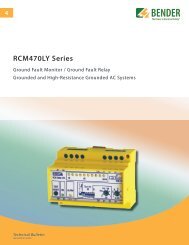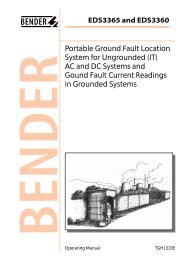EDS470 - Bender
EDS470 - Bender
EDS470 - Bender
You also want an ePaper? Increase the reach of your titles
YUMPU automatically turns print PDFs into web optimized ePapers that Google loves.
Installation and wir ing<br />
Coordination with the<br />
insulation monitoring<br />
device<br />
A prerequisite for operating the <strong>EDS470</strong> system is a central insulation monitoring<br />
device. If an insulation fault falls below the set response value of alarm 2 of the<br />
insulation monitoring device, this device activates the insulation fault location<br />
system <strong>EDS470</strong>. Depending on the type of the system, either the test device<br />
PGH471 is directly activated or the control and indicating device PRC470 is<br />
activated. Apart from system start by means of the insulation monitoring device it<br />
also can be started manually.<br />
When choosing the insulation monitoring device, the condition of the entire<br />
installation must be considered. It is highly recommendable to use a device of<br />
the series IRDH265-4/365-4 or IR475LY. By means of this device DC, AC and<br />
3AC systems can be monitored. Due to the AMP measuring principle, mixed<br />
systems or systems with variable-speed drives are also safely monitored.<br />
During insulation fault location, the insulation monitoring device is set to<br />
internal test mode because an active measurement is not possible because of the<br />
test current generated by the PGH471.<br />
Depending on the device which is used, it may be sensible for the measurement<br />
input of the insulation monitoring device on the coupling side to be<br />
disconnected from the system for the duration of the insulation fault location.<br />
This will avoid influencing the response sensitivity. This applies to insulation<br />
monitoring devices with an internal DC resistance < 120 kΩ, e.g. IRDH265-3 and<br />
IRDH365-3 with 28 kΩ.<br />
Reason: for safety reasons, the test current of the <strong>EDS470</strong> system is restricted to<br />
25 mA resp. 10 mA. If the insulation monitoring device remains connected<br />
during insulation fault location, part of the test current flows to earth via the<br />
internal resistance of the device. Thereby the sensitivity of the system is reduced.<br />
The degree of the influence depends on the internal DC resistance R i<br />
of the<br />
insulation monitoring device and the value of the insulation fault.<br />
The use of an insulation monitoring device with an R i<br />
of 28 kΩ in a 3AC 400 V<br />
system has no influence on the maximum sensitivity of the system. However, if<br />
several insulation faults occur, the measurement current which is available from<br />
the test device will also be split up on the insulation fault monitoring device,<br />
thus reducing the possibility of detecting several faults.<br />
The following insulation monitoring devices are to be recommended:<br />
Nominal A-ISOMETER Special features Decoupling<br />
system voltage<br />
necessary<br />
AC ≥ 230V IRDH265/365-4 High capacitances up to 500µF, no<br />
3AC ≥ 230V response range system interferences,<br />
DC ≥ 110V 10…990 kΩ converters, serial interface, display<br />
AC 24-230V IRDH265/365-3 High capacitances up to 500µF, yes<br />
3AC 24-230V Response range system interferences,<br />
DC 24-110V 2…200 kΩ converters, serial interface, display<br />
AC 24-230V IR475LY Capacitances up to 20µF, no<br />
3AC 24-230V Response range type of casing<br />
DC 24-110V<br />
2…200 kΩ<br />
34<br />
TGH 1243E/02.2000



